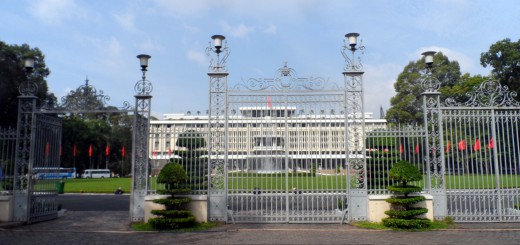Municipal Theatre (Saigon Opera House)
NOTE: – There is a new and updated version of this article over on our main website. https://catchourtravelbug.com
You can find the latest version by clicking –>> Saigon Opera House. Ho Chi Minh City’s Best Performance Venue?
The Municipal Theatre, otherwise known as the Saigon Opera House, sits in Lam Son Square at start of Le Loi Street. Le Loi is the popular shopping street that runs from the park across the road through to Ben Thanh market. The surrounding area could be in one of Europe’s finest cities were it not for the usual crazy traffic on the surrounding streets. It is adjacent to the classical Continental Hotel and is close to other impressive architectural beauties like the new Union Square shopping plaza, The Rex Hotel and Saigon City Hall. It’s proximity to other popular sites make it a logical stop on any walking tour around Ho Chi Minh City.
The Municipal Theatre was originally built to entertain Saigon’s burgeoning middle class in French Colonial times. A number of French Architects were involved with the creation of the original building that was completed in 1897. Felix Olivier, Ernest Guichard and Eugene Ferret are all mentioned at various stages of design and construction. The building was designed as a classical opera house and built in the flamboyant style of the French Third Republic. The original façade bore an uncanny resemblance to the Petit Palace built the same year in France. Inscriptions and furnishings were drawn by a French artist and the applied ornaments, balustrades, cartouches and roof were originally imported from France.
In the early 1940’s, the theatre was thought to be too ornate and many of the fancier adornments were removed. Parts of the building were also damaged by allied aerial attacks against the Japanese Imperial Army. Luckily many of the original architectural features still remained such as the stone verandah, white stone statues at the entrance, the colorful granite tiled floors, chandeliers, bronze statues in front of the stairs, richly engraved auditorium arch and wall statues.
The Municipal Theatre wasn’t always used as an entertainment venue. After the French were defeated at The Battle of Dien Ben Phu and the Geneva Accords were reached, the theatre was briefly used as a shelter for French citizens emigrating from the north. By 1956 enthusiasm for its use as an entertainment had waned significantly and it was converted into the Lower House of Assembly for the South Vietnamese Government. When the Vietnam War was over and there was no longer a need for the assembly, it was once more converted into a theatre.
In 1998, as part of Saigon’s 300th birthday celebrations, famous architects and artists were invited to assist in restoring the theatre to its former glory. The renovation was top notch and the complex now features state-of-the-art lighting, sound and safety equipment. Exterior lights were installed in 2005 which means you can now get some stunning night shots.
Unless you are attending a performance of some sort you can’t get very far into the building but that shouldn’t be an issue if you really want to get inside. The Municipal Theatre hosts the Ho Chi Minh City Ballet Symphony Orchestra and Opera and therefore a variety of traditional and classical performances are staged there. These include plays, concerts, ballets, opera and Vietnamese traditional dance.
One of the current shows may just be worth your time and money. AO Show is a cross between Cirque de Soleil, martial arts and dance and has travelled the world to wide acclaim. It portrays rural scenes from Southern Vietnam through an extremely energetic, visually stunning acrobatic performance. Now back in Ho Chi Minh City you can attend several performances each week for varying prices. The show will be running until at least December 2014. Kill two birds with one stone by getting a taste of contemporary Vietnamese dance and getting a peek into the interior of the Theatre. The venue is also for graduation ceremonies for some of the more elite academic institutions around town but I’m pretty sure you would need an invitation to worm your way inside.
If you don’t want to buy a ticket to see a performance you can still enjoy a show. On Sundays a brass band plays on the steps so you can just wander down and join the locals for a bit of pomp and ceremony. There’s also no problem, as far as I’m aware, in just having a rest on the steps under the façade and watching the world go by in one of the loveliest areas in town. If you are following my day 1 itinerary for walking around Ho Chi Minh City you may well need to take a load off before continuing on your way. Whatever you do, don’t miss at least getting one day and one night picture of the Municipal Theatre. They will definitely be some of your finest from your visit to Ho Chi Minh City.
[mapsmarker marker=”15″]
Note: I do not receive any payment for this post (or any others on the site for that matter!). I do receive a small amount of money by allowing advertisements on the site and any purchases made through those links.













Such a great post <3 Thank you for your very interesting information. Sure that I will visit the Saigon Opera house one day